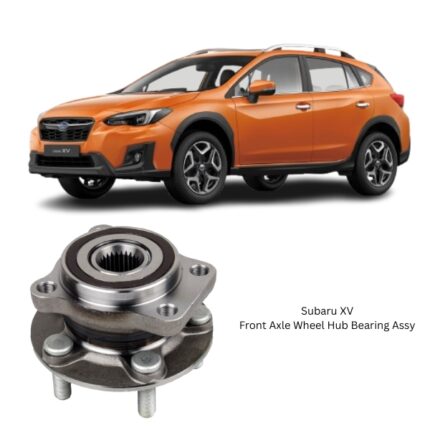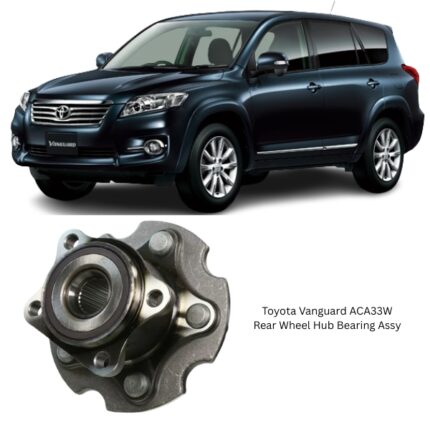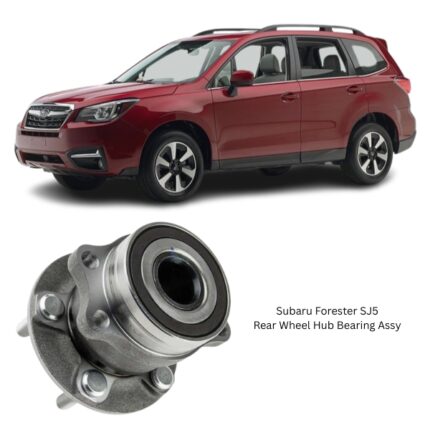Get Subaru Forester SJ5 Rear Wheel Hub Bearing Assy 28473-FJ020 in Kenya
The Front Wheel Hub Bearing Assembly RH/LH is an integral component in the front suspension and steering system. It supports and enables the rotational movement of the front wheel while maintaining its structural alignment with the steering knuckle and brake system. This component is a self-contained unit that combines a precision-engineered bearing with a robust wheel hub, engineered for either right-hand (RH) or left-hand (LH) placement on the vehicle’s front axle.
Highly subjected to complex stresses—ranging from vertical loads to lateral forces and rotational torque—the front wheel hub bearing assembly is critical to the safe and smooth operation of a vehicle. It is tasked not only with carrying vehicle weight and allowing wheel rotation, but also with resisting cornering forces, transferring braking torque, and ensuring precise sensor readings in systems like ABS or traction control.
Core Functions
The primary functions of the Front Wheel Hub Bearing Assembly include:
-
Enabling smooth wheel rotation with minimal friction.
-
Supporting vertical and horizontal loads, including those from braking, acceleration, and cornering.
-
Maintaining wheel alignment with respect to the suspension, brake, and steering geometry.
-
Providing a structural mounting point for the wheel and brake disc or drum.
-
Interfacing with the ABS system through integrated sensor rings or magnetic encoders.
These combined functions make it an essential convergence point in the front-end mechanical system.
Component Structure
The assembly typically includes several subcomponents engineered to work together as a sealed unit:
1. Wheel Hub
The hub is the outward-facing flange onto which the wheel is bolted. Usually made from forged steel or cast iron, it is designed to distribute load evenly across the wheel and absorb dynamic stresses during motion. The hub includes mounting studs or bolt holes arranged in a specific bolt pattern to ensure structural integrity and even torque distribution.
2. Bearing Unit
The core of the assembly is the bearing itself, generally of the double-row ball bearing or tapered roller bearing type. These bearing types are ideal for handling both radial and axial forces, ensuring smooth rotation under high loads. The bearing is pre-packed with high-performance grease and sealed for life to prevent contamination and reduce maintenance requirements.
3. Mounting Flange/Bracket
The rear side of the assembly includes a machined flange or mounting face that connects directly to the steering knuckle or control arm via bolts. The precision of this interface is critical to maintaining wheel alignment and ensuring accurate brake disc positioning.
4. ABS Encoder/Tone Ring (If Equipped)
Most modern units include a built-in encoder ring or magnetic tone wheel for ABS integration. This allows the wheel speed sensor to track rotation speed and feed data to the anti-lock braking system, ensuring proper braking control under varied driving conditions.
5. Seal System
Multiple sealing elements are employed to protect the bearing assembly from environmental intrusion. High-performance elastomeric seals resist dust, water, road salts, and other contaminants, while also retaining the internal lubrication over the product’s lifespan.
Material and Manufacturing Attributes
The front hub bearing assembly is engineered using durable and performance-oriented materials. Common choices include:
-
High-carbon steel for bearing races and rolling elements, heat-treated to resist fatigue and wear.
-
Forged or cast steel for the hub body, offering strength and rigidity under dynamic loads.
-
Rubber-polymer composite seals for optimal environmental resistance.
-
Anti-friction coatings and advanced synthetic lubricants to reduce operating temperature and wear over time.
Precision machining and quality control processes ensure tight tolerances, proper preload settings, and consistent performance across service life.
Operational Stress Factors
The component is exposed to a wide range of operational stresses:
-
Radial Load: Arising from the vertical weight of the vehicle.
-
Axial Load: Generated during turns and steering maneuvers.
-
Torsional Load: Caused by braking and acceleration forces.
-
Thermal Load: From both internal bearing friction and nearby braking systems.
-
Contamination Risk: Due to proximity to the road surface and braking elements.
Each of these conditions has been considered in the assembly’s design and material selection to ensure resistance to wear, noise, vibration, and deformation.
Common Symptoms of Wear or Failure
As a high-stress component, the front wheel hub bearing assembly is subject to degradation over time. Indicators of wear or impending failure include:
-
Grinding or rumbling noises that increase with vehicle speed.
-
Wheel wobble or free play when the tire is manipulated by hand.
-
Vibrations felt through the steering wheel, especially at higher speeds.
-
ABS warning light activation caused by encoder or sensor issues.
-
Increased stopping distance or irregular brake response.
Timely inspection and replacement of a failing hub bearing assembly are vital to maintaining vehicle safety and driving precision.
Installation and Fitment Considerations
Installation of the front hub bearing assembly requires strict adherence to torque specifications, surface cleanliness, and alignment protocols. Key steps include:
-
Surface preparation: Clean all contact points to eliminate rust, debris, or corrosion.
-
Correct torque application: Use a torque wrench to apply recommended values to axle nuts and mounting bolts, ensuring bearing preload is maintained.
-
ABS sensor alignment: For ABS-equipped assemblies, ensure that the sensor is properly positioned and the encoder is clean and undamaged.
-
Proper support and alignment tools: Use of bearing press tools or hydraulic equipment may be required for seated installation, depending on the design.
Improper installation may result in bearing misalignment, noise, premature wear, or mechanical failure.
Maintenance Guidelines
While most hub assemblies are non-serviceable and sealed for life, vehicle owners and technicians can extend the component’s longevity with the following practices:
-
Regular inspection during brake or suspension servicing.
-
Avoidance of high-pressure washing near wheel hubs, which could compromise seals.
-
Proper wheel installation using manufacturer-specified torque to avoid distortion.
-
Monitoring of unusual sounds or vibrations during operation for early detection.
Routine vehicle checks and accurate driving habits contribute to longer bearing life and safer performance.
Functional Role in the Broader Vehicle System
The front wheel hub bearing assembly serves as a mechanical and dynamic interface between several critical systems:
-
Suspension: It maintains geometry and controls vertical and lateral forces.
-
Steering: It allows for the articulation of the front wheels while resisting deflection.
-
Braking: It provides the anchor for the disc or drum and ensures consistent caliper clearance.
-
Traction and Stability Control: It supports real-time feedback through ABS sensors, contributing to automated control systems.
Any failure in this part can negatively impact all of these systems, resulting in degraded performance or safety hazards.
Follow us on Facebook for more parts.





Reviews
Clear filtersThere are no reviews yet.